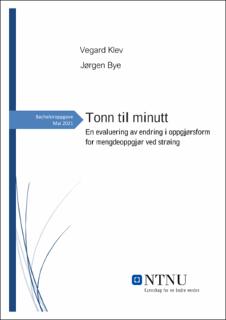| dc.contributor.advisor | Haug, Ole Kristian | |
| dc.contributor.author | Bye, Jørgen | |
| dc.contributor.author | Klev, Vegard | |
| dc.date.accessioned | 2021-09-24T19:23:32Z | |
| dc.date.available | 2021-09-24T19:23:32Z | |
| dc.date.issued | 2021 | |
| dc.identifier | no.ntnu:inspera:77257390:81861940 | |
| dc.identifier.uri | https://hdl.handle.net/11250/2782289 | |
| dc.description.abstract | Denne bacheloroppgaven har til hensikt å evaluere omleggingen av mengdeoppgjøret for norske driftskontrakter, med hensyn til strøing av veger med sand og salt. Studien er utført på vegne av Viken fylkes seksjon for drift og vedlikehold i Viken vest. Viken ønsker med denne studien å utrede hvilke oppgjørsform for strøing som er mest hensiktsmessig med tanke på kvalitet og økonomi.
Denne studien kombinerer flere metoder for å danne et godt analysegrunnlag for konklusjonen. Oppgaven benytter seg av litteraturanalyse for analyse av allerede publisert arbeid. Litteraturanalysen dannet grunnlag for videre casestudier, der forskjellige konkrete beregninger gav godt grunnlag for konklusjonen. Beregningene baserer seg på de respektive kontrakters D1-kapitler, samt analyse av tallgrunnlag innhentet fra Statens Vegvesen og bransjeforeningen EBA. Resultatet av disse analysene blir sett opp mot samtaler gjennomført med en håndfull fagfolk i bransjen, som kom med erfaringsbaserte innspill og tilbakemeldinger.
Studiens resultater viser en klar nedgang i mengdeoppgjørets satser etter omleggingen fra tonn til minutt. Dette har skjedd selv om bestiller har kommunisert ut at mengdeoppgjørets satser følger 2/3-prinsippet. Dette samsvarer godt med entreprenørenes innspill til oppgaven, og gjennom sammenligningen av Statens vegvesens grunnlag med EBAs grunnlag. Beregningene viser også mengdeoppgjørets påvirkning av hastighet og dosering, der minuttoppgjørets største fordel kommer frem. Studien viser også en sammenligning mellom D1 i 0604 Hallingdal 2019-2024 og 9102 Hallingdal og Valdres 2021-2026. Sammenligningen viser en stor utvikling i mengdeoppgjørets satser. Basert på resultatet viser studien at minuttoppgjør er mest hensiktsmessig for Vikens nye driftskontrakter. Det er likevel viktig at 2/3-prinsippet følges, og at mengdeoppgjørets grunnlag blir tydelig kommunisert ut fra bestiller. | |
| dc.description.abstract | The purpose of this bachelor thesis is to evaluate the reorganization of the quantity settlement of Norwegian operating contracts, concerning scattering of salt and sand on roads. The study is conducted on behalf of Viken County Municipality’s section of operation and maintenance in Viken west. With this study, Viken wishes to examine which forms of settlement for friction increasing measures prove to be most appropriate regarding quality and economy.
This study combines several research methods in order to form a comprehensive analytical basis for the conclusion. The thesis uses literature review to analyse already published work. The literature review created the basis for further case studies, in which several specific calculations provided a plausible basis for the conclusion. The calculations are based on the D1 chapters of the respective contracts, in addition to analyses of numerical basis gathered from the Norwegian Public Roads Administration and the industry association EBA. The result of these analyses is compared to conversations conducted with a handful of professionals in the industry who provided valuable experience-based input and comments.
The result of this study shows a clear decrease in the quantity settlement rates after the reorganization from tons to minutes. This has been the case even when the customers have communicated that the quantity settlement rates follow the 2/3 principle. This is in line with the contractors’ input, and the comparison of the Norwegian Public Roads Administration and the EBA. The calculations also show the quantity settlements influence on the speed and dosage, in which we find the greatest advantage in the minute settlement’s favor. The study also compares D1 in 0604 Hallingdal 2019-2024 and 9102 Hallingdal and Valdres 2021-2026. The comparison shows a considerable development in the rates of the quantity settlement. Based on these results, the study posits that minute settlement is most advantageous for Viken’s new operating contracts. However, it is important that the 2/3 principle is followed, and that the basis of the quantity settlement is clearly communicated by the road administration. | |
| dc.language | nob | |
| dc.publisher | NTNU | |
| dc.title | Tonn til minutt | |
| dc.type | Bachelor thesis | |
